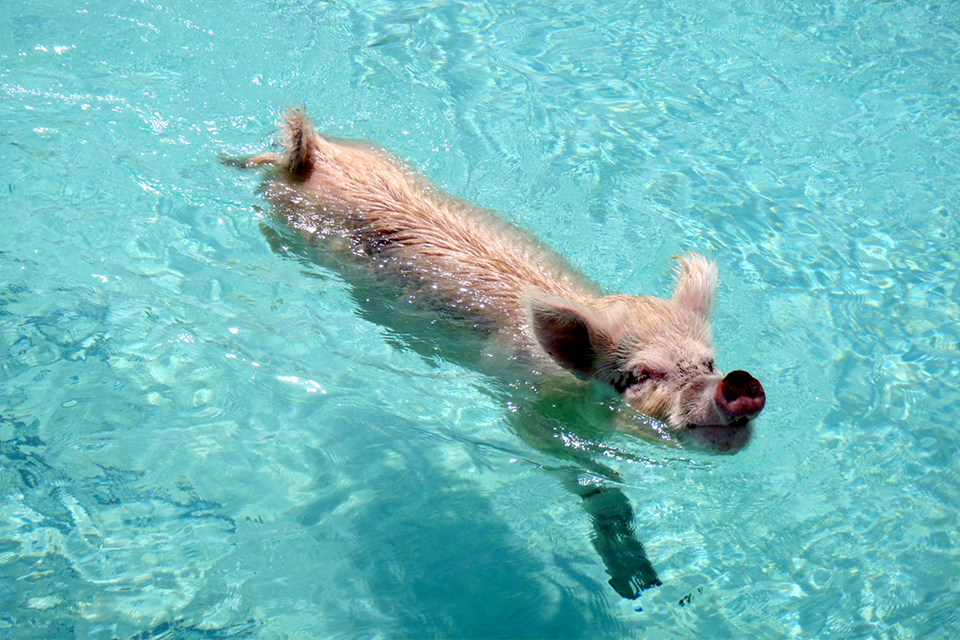Sink or Swim

“All mammals can swim. It’s a fact!” Or so said my high school science teacher back in the early 80s. Skip a few years down the road and my friend suggested a road trip to San Marcos to see Ralph the Swimming Pig. Recalling the words of wisdom from my former science teacher, I quickly barked back, “A pig would already know how to swim. It’s nothing amazing to see.” I firmly believed that all mammals already innately knew how to swim, and spending hours out of my day to watch a pig splash around was the last thing that I wanted to do.
The reality is that all mammals do not innately know how to swim. Giraffes, porcupines, and apes sure don’t know how. Humans are not born with the knowledge of how to swim, although they can be taught how. While humans are the only mammals with the ability to learn a wide variety of swim strokes, to say we innately know how to swim is false.
Growing up with a pool close by for my whole life, I always took for granted my ability to swim and be comfortable in the water. At the early age of three, and after taking multiple swim lessons, I was able to float on my back, dive underwater, and get myself out on the side of the pool. Because of my early instruction, I had learned all four swim strokes by the age of four.
All this early instruction paved the way for my future aquatic endeavors—everything from my first job as a lifeguard to being a member of the USA National Swim Team, racing as a professional triathlete to teaching swim lessons, becoming the head coach for multiple swim teams to working at my current job as an Aquatics Manager for the JCC Austin.
I was very fortunate in that my parents supported and facilitated my aquatic resume. They understood how important it was for me to learn how to swim at an early age, and empowered me to build and strengthen that skill. My parents are the minority. Most of society lacks the forethought they had and needs to educate itself on the importance of learning to swim at a young age. Drowning is the leading cause of unintentional injury or death for children 4 years old and younger, and it’s the fifth leading cause of unintentional injury or death for all Americans.
The number one action people can take to help reduce the risk of drowning is to enroll children in proper swim lessons at an early age, and create a strong foundation for a lifetime.
The first thing a good swim instructor will teach a child is how to be swim-safe and learn how to save themselves in a possible drowning scenario. Within this basic first skill, the child learns proper body and head position in the water, ultimately setting the stage for learning proper stroke mechanics in all four strokes, including freestyle.
On a regular basis, I see adult clients who were never taught these basic principles for swimming. They may say they are able to swim, but their form demonstrates a lack of understanding for the basics. I would venture to say that 90 percent of all adults I work with require at least two to three weeks of professional instruction on body and head position before I am able to work on their actual stroke mechanics. Once I am able to get their body positioning correct and relaxed, a whole new world of ability shines through with learning new strokes and proper technique. Not only are they comfortable in the water, but their enjoyment of the activity is enhanced and they are finally able to build better fitness from an aquatic workout.
One piece of advice I give to parents and adult swimmers is to enlist in high quality swim lessons as soon as possible. It will not only help adults in their own safety, but enable a child to be safer in the water; forming the foundation for unlimited potential with their swimming endeavors.
I never did get a chance to go see Ralph the Swimming Pig in person, and his performances are now a part of San Marcos history. I wonder if he still recreationally swims laps somewhere and what shape his swimming form is in? If you happen to share a lane with him someday, do me a favor and let me know.






